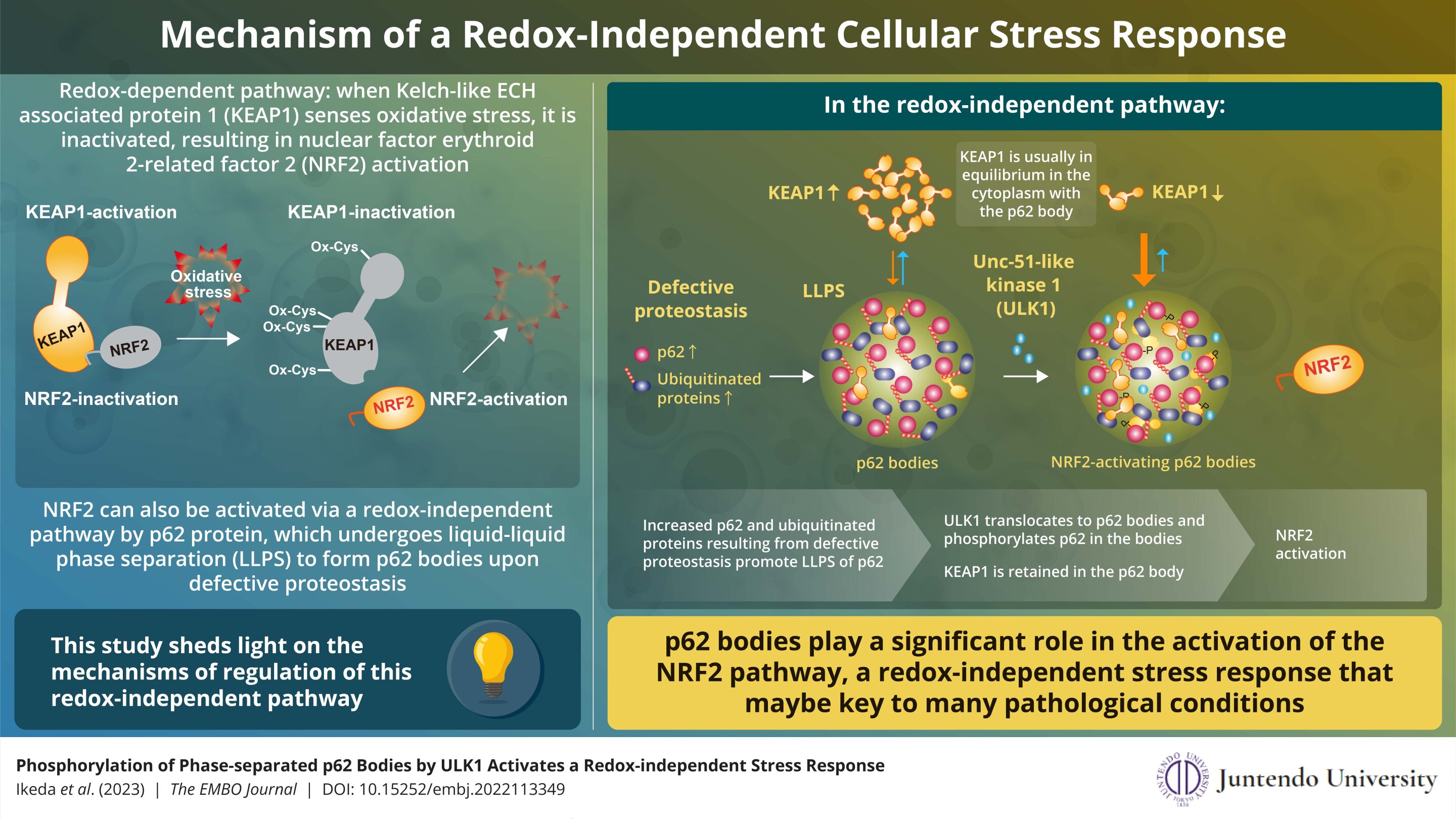
Cellular stress, or oxidative stress, occurs due to the buildup of reactive oxygen species (ROS), which can cause damage to proteins, lipids, and DNA within cells. To combat this, cells have developed mechanisms to remove ROS and decrease oxidative stress, with nuclear factor erythroid 2-related factor 2 (NRF2)-mediated stress response being a key mechanism. NRF2, a master transcription factor, is responsible for reducing oxidative stress by inducing genes that encode anti-oxidative proteins.
While the redox-dependent activation of NRF2 is well-understood, the redox-independent activation of NRF2 remains less explored. However, researchers from Juntendo University in Japan have made a groundbreaking discovery regarding redox-independent activation, shedding new light on this crucial pathway. Specifically, the team discovered that ULK1 phosphorylates p62 within the biomolecular condensate, leading to enhanced NRF2 activation. This finding has important implications for understanding the regulation of stress response and fighting oxidative stress, which can damage DNA, lipids, and proteins within cells.
The precise mechanism of NRF2 regulation through p62 bodies had been unknown until this study was conducted. The researchers utilized advanced techniques such as high-speed atomic force microscopy, fluorescence recovery after photobleaching, and fluorescence loss in photobleaching to extensively explore interactions between proteins and cellular components, as well as effects of LLPS-induced p62 phosphorylation in redox-independent NRF2 activation. Through these strategies, they verified their hypothesis that ULK1 phosphorylates p62 within the biomolecular condensate. This, in turn, leads to enhanced NRF2 activation due to phosphorylated p62 bodies retaining KEAP1, which then activates more NRF2. Importantly, p62 bodies are degraded by autophagy, contributing to shutdown of this pathway.
Prof. Masaaki Komatsu, who led the study, commented on the importance of their research, stating, “Understanding the regulatory mechanisms of NRF2 activation is crucial, as persistent activation can lead to excessive defense responses. Our study is the first scientific validation of the physiological significance of redox-independent NRF2 activation. Research such as ours will be useful in elucidating the pathogenesis of p62-, NRF2-, and autophagy-related diseases and developing improved therapies.” The team’s findings were published in The EMBO Journal.
This study highlights the crucial role of stress response and offers new insights into regulating oxidative stress. With such advancements, researchers can continue to unveil the mysteries of cellular mechanisms and understand the causes of various illnesses, allowing for improved therapies and better treatments.
More information:
Ryo Ikeda et al, Phosphorylation of phase‐separated p62 bodies by ULK1 activates a redox‐independent stress response, The EMBO Journal (2023). DOI: 10.15252/embj.2022113349
Provided by
Juntendo University Research Promotion Center
Citation:
Research offers insights into redox-independent cellular stress response (2023, June 12)
retrieved 12 June 2023
from https://phys.org/news/2023-06-insights-redox-independent-cellular-stress-response.html
This document is subject to copyright. Apart from any fair dealing for the purpose of private study or research, no
part may be reproduced without the written permission. The content is provided for information purposes only.
Denial of responsibility! SamacharCentrl is an automatic aggregator of Global media. In each content, the hyperlink to the primary source is specified. All trademarks belong to their rightful owners, and all materials to their authors. For any complaint, please reach us at – [email protected]. We will take necessary action within 24 hours.

Shambhu Kumar is a science communicator, making complex scientific topics accessible to all. His articles explore breakthroughs in various scientific disciplines, from space exploration to cutting-edge research.

